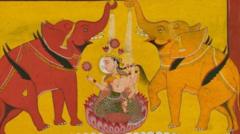A captivating new exhibition at the British Museum in London, titled "Ancient India: Living Traditions," invites visitors to explore the vast and intricate journey of India's spiritual art, presenting 189 outstanding objects that span many centuries. This exhibition encompasses a rich array of ancient sculptures, paintings, narrative panels, and manuscripts that demonstrate how spiritual expression in India has evolved over time.
Between 200 BC and AD 600, the visual representation of gods, goddesses, and enlightened beings in Indian art experienced a significant transformation. Early imagery, which was highly symbolic, eventually shifted to more human-like forms, reflecting a dynamic intersection of three ancient religions: Hinduism, Buddhism, and Jainism. "It's fascinating to observe how we've come to envision these spiritual figures. A human-like form is now fundamentally linked with divine worship across these faiths," remarks Sushma Jansari, curator of the exhibition.
The exhibition's five sections delve into this evolution, starting with the veneration of nature spirits, and detailing distinct sub-sections for each of the religions before concluding with the movement of these faiths and their artistic traditions to nearby regions such as Cambodia and China.
A highlight of the Buddhist section is a remarkable two-sided sandstone panel illustrating the evolution of Buddha's representation. One side, dated to AD 250, presents the Buddha in intricate human form, while the opposite side, dated around 50-1 BC, depicts him symbolically through an empty throne and footprints. The curator considers this one panel's ability to encapsulate such a pivotal artistic evolution as truly extraordinary.
In the Hindu section, an early bronze statue exemplifies the gradual development of sacred imagery, portraying a goddess who embodies both the nurturing and destructive attributes of a yakshi, a nature spirit. The figure's representation includes multiple arms carrying sacred objects, forming a foundation for future depictions of Hindu deities.
Jain art is represented through striking pieces focusing on the tirthankaras, the 24 enlightened teachers. The earliest depictions date back roughly 2,000 years, identified by the symbol of an endless knot featured on the teachers’ chests.
This exhibition stands out for presenting the origins of these three religious artistic traditions collectively, rather than in isolation. The artifacts come from a diverse range of contributors, showcasing the interconnected history of these spiritual dimensions. Every exhibited item is meticulously documented to illustrate its historical journey through various collections.
Amidst this rich display, the exhibition also incorporates a multi-sensory experience with ambient sounds, fragrances, and vibrant colors, designed to give visitors a sensory insight into active religious spaces. "It's important to convey the serenity combined with vibrant activity of these sacred locations," says Jansari, who worked with numerous artists and community collaborators.
In conjunction with the artworks, screens exhibit short films featuring practitioners of these religions in the UK, reinforcing that this exhibition reflects "not just ancient art but a living tradition" that resonates with millions today. This extensive collection, drawn from the British Museum's South Asian artifacts and bolstered by 37 loans from institutions worldwide, will be on display until October 19, providing a deep dive into the essence of India's spiritual artistry.



















